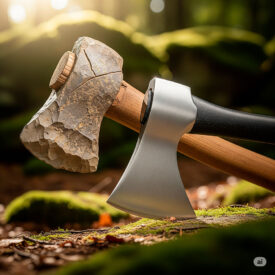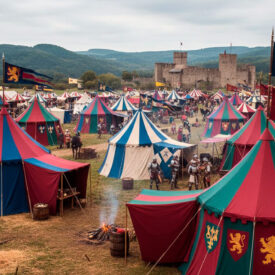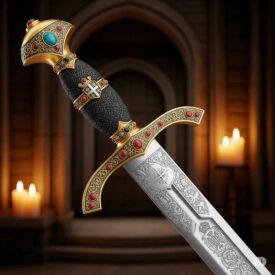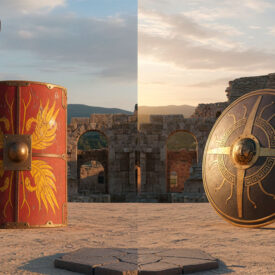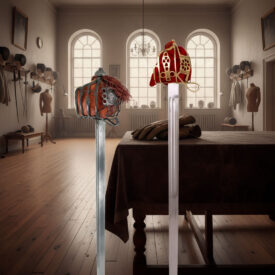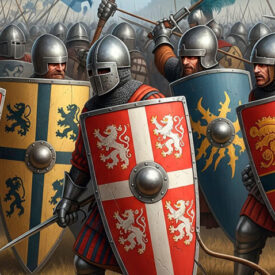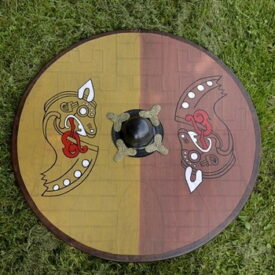A blade shining under the northern rain, a seasoned wooden handle vibrating with the echo of shields: thus is born the classic image of warrior axes. In this article, we will explore how these weapons, forged between necessity and legend, came to define tactics, symbols, and techniques that endure in historical reenactment and popular culture.
Why did axes earn a preferred place in armies and collective memory? Because they are simple in conception and complex in use: they combine balance, edge, and a design intimately linked to the culture of the warrior who wields them. Here you will learn to identify key types, understand their historical evolution, know their tactical uses, and discover how they were manufactured and maintained. In addition, we will see practical comparisons, a detailed chronology, and technical advice on throwing and conservation.
Medieval Axes: Evolution and Historical Milestones
The history of axes extends from the first stone tools to the specialized pieces of the late Middle Ages. The following chronology gathers the essential milestones to understand how humble weapons became emblems of warriors.
| Era | Event |
|---|---|
| Ancient Origins | |
| Prehistoric Times | Axes have been used as tools and weapons since very early times. |
| Before the 5th century | The francisca is already known as a traditional weapon of the Western Germans before its association and popularization by the Franks. |
| Early Middle Ages (5th–8th centuries) | |
| 5th–8th centuries | The francisca (also called francesca), an axe of Western Germanic origin, is assiduously employed by the Franks from the Merovingian to the Carolingian dynasty; its name reflects that ethnic connection. |
| Year 486 | In the Battle of Soissons, the francisca plays a decisive role when Clovis I defeats the Roman forces of Syagrius, consolidating the Frankish Kingdom. |
| Year 507 | The francisca again proves effective in the Battle of Vouillé against the Visigoths. |
| Evolutionary Design | Early franciscas feature a simple design; over time, versions with more complex shapes and decorations appear. |
| 11th Century | |
| General context, 11th century | The francisca and other types of axes influence the weapons of early medieval Europe. |
| October 14, 1066 (Battle of Hastings) | The Anglo-Saxon army includes numerous huscarls equipped with axes:
|
| 12th–13th Centuries | |
| 12th century | In northern Europe, the battle axe (securis, securis missilis, francisca, bipennis) evolves and is known by Celtic and Germanic peoples. |
| 13th century | The Danish axe achieves great popularity, although it begins to lose prominence due to changes in defenses, tactics, and army composition. Viking axes (battle, two-handed, and throwing) are relevant weapons in Norse culture. |
| 13th century (Sidon Castle) | In mass graves at Sidon Castle (Lebanon), remains of 13th-century crusaders show wounds from swords and maces; the finding contextualizes the violence of the era although it does not specifically enumerate axe wounds. |
| Late 15th – Early 16th Century (Castilian Context) | |
| 15th century | In Castilian fortresses such as Pedraza de la Sierra and Torremormojón, axes form part of the offensive armament along with swords, spears, and daggers. |
| 1506 (Torremormojón Inventory) | Five bundles of darts with their irons are registered and a hand axe of arms is mentioned. |
| 1512 (Pedraza de la Sierra Inventory) | A total of 48 axes are counted; two types are distinguished: hand axes (less numerous, small) and battle axes (majority, 37 pieces), divided into large and small — ten of the small ones are garnished in silk and leather, indicating a stately or luxurious character. |
| Modern Legacy | |
| Present Day | The francisca and other historical axes are maintained in throwing competitions, historical reenactments, and popular culture (novels, cinema, video games), preserving their image as a symbolic medieval weapon. |
Key Types and How to Recognize Them

Before delving into mechanics and techniques, it’s essential to recognize the variants grouped under the label “warrior axes.” Below you’ll find a practical guide to identify them by their shape, function, and historical context.
Francisca
The francisca is the traditional Frankish axe: asymmetrical, with a blade that favors throwing and cutting. It was relatively short (50–60 cm) and just heavy enough to impart stable rotation when thrown. It was a weapon designed for mass combat and breaking formations.
Viking and Danish Axes
In Norse culture, variety reigns: hand axes, throwing axes, and the large two-handed Danish axes. Viking axes show a relationship between tool and weapon; their aesthetics are often decorated with animal motifs and runes.
Battle Axe and Pollaxe
When plate armor appears, the axe evolves: breastplates, spikes on the reverse, and designs intended to penetrate or deform armor. Pollaxes are the result of this specialization, combining edge and percussive power in a single instrument of war.
Functional Comparison: How Shape and Weight Influence
Understanding the difference between a throwing axe and a striking axe is key to interpreting its use in battle. The following table summarizes important attributes.
| Type | Approximate Weight | Shaft Length | Tactical Advantage |
|---|---|---|---|
| Francisca | 600–900 g | 50–60 cm | Throwable and effective against formations; excellent rotational balance. |
| Viking Axe (hand) | 600–1200 g | 40–70 cm | Versatile for combat and tasks; fast in close-quarters exchange. |
| Danish Axe (two-handed) | 1.5–3 kg | 120–180 cm | Great cutting power and reach; devastating against light armor. |
| Battle Axe / Pollaxe | 1–2.5 kg | 70–120 cm | Designed to penetrate and deform armor; combined with picks and back-blades. |
Forging, Materials, and the Blacksmith’s Secrets
Warrior axes were forged with a blend of pragmatism and metal knowledge. A good edge was obtained by combining iron and steel, sometimes through welding techniques or by inserting a harder strip into the edge.
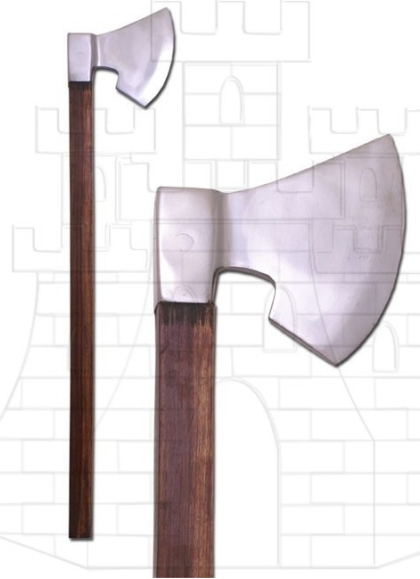
Controlled tempering was essential: a hard edge and a more ductile spine reduced the risk of fracture. The eye where the handle is fitted was reinforced with rings or metal collars to prevent the head from coming loose in combat.
Woods and Grips
Ash and walnut were frequent choices for their combination of strength and flexibility. Handles were curved and tempered to absorb blows and improve grip. On status examples, leather, silk coverings, or decorative inlays were used.
Combat Techniques: Impact, Hooking, and Throwing
An axe is not just brute force; its effectiveness lies in technique. From arc cutting to hooking an enemy’s breastplate, maneuvers require control of balance and center of gravity.
Throwing axes, like the francisca, depended on controlled rotation: a clean throw with precise release makes the blade hit at the optimal angle to embed itself. In close combat, axes were wielded with upward and downward cuts, targeting exposed surfaces or armor joint points.
Control Maneuvers
- Hooking: using the “beard” of an axe to catch a shield or spear and destabilize the enemy.
- Hinge strike: impacting with the upper part of the blade to bend or break an armor edge.
- Short cut: rapid movements aimed at weakening defenses before a larger assault.
Replicas, Modern Use, and Preservation
Today, historical axes live on in functional replicas, decorative pieces, and LARP items. Each replica requires design decisions that balance authenticity, safety, and functionality.
Maintenance and Conservation
A well-maintained edge prevents breakage: cleaning after use, protection with oils, and storage in dry places are essential. Mineral or camellia oils and non-acidic greases help protect the metal without damaging it.
| Type of Oil | Main Characteristics | Recommended Use |
|---|---|---|
| Mineral Oil | High penetration, does not degrade or attract dirt | Regular protection and maintenance |
| Camellia Oil | Natural, acid-free, non-volatile | Antioxidant protection, lubrication |
| Lithium Grease | Dense, durable, does not evaporate | Long-term storage, protection |
- Mineral Oil
-
- Characteristics: High penetration, does not degrade or attract dirt
- Recommended Use: Regular protection and maintenance

How to Choose a Replica According to Your Purpose
The objective conditions the choice: a display piece may prioritize decoration and finishes; a functional one must offer tempering, a reinforced eye, and a quality handle. For LARP, safety and materials with finishes without dangerous edges are prioritized.
Quick Checklist
- Authenticity of profile and dimensions.
- Steel quality and tempering test.
- Eye reinforcement and firm handle fit.
- Handle finishes and covering materials.
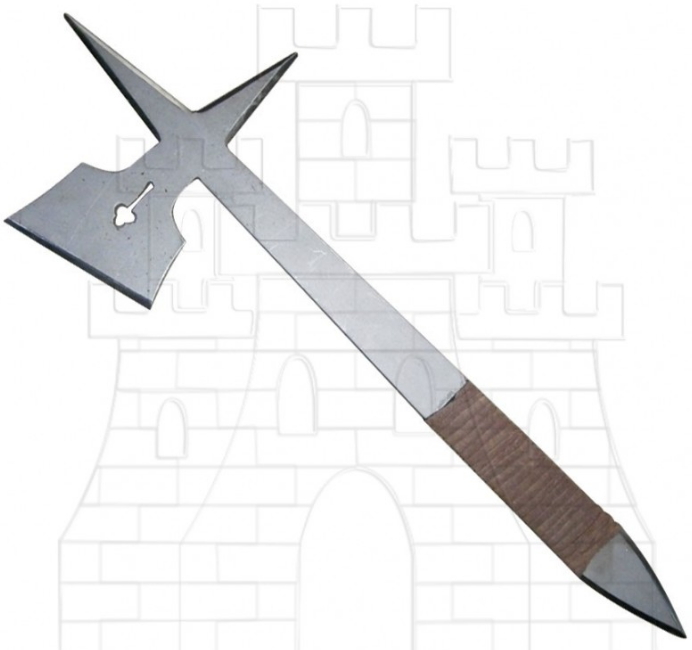
Clarifying Doubts About the Francisca Axe and its Historical Context
What were the most effective techniques for throwing a francisca axe?
1. **Two-handed throw**:
– Hold the axe firmly with both hands, aligning the blade so the edge does not tilt to either side.
– Raise the axe above your head with your torso slightly tilted backward to gain momentum.
– Throw with a quick, dry movement, releasing the axe when your arms are extended in front of your torso.
– Bending the knee and keeping the elbow in a perpendicular position improves stability and control.
– Shoulders and hips should be parallel to the target to ensure accuracy.
2. **One-handed throw** (more advanced):
– Place one foot forward, maintaining shoulder-width distance.
– Lower the arm down the outside of the leading leg, then raise the axe after passing the leg.
– Propel the axe forward when it is at head height and release it when the arm is parallel to the ground, with a firm and unhesitating throw.
3. **Key technical details**:
– The elbow should be close to the body and the arm straight in the backward movement.
– The axe is released at the precise moment to make it rotate the necessary amount to embed itself in the target, generally when half of the handle is in peripheral vision.
– Allowing the arm to follow through after the throw helps maintain fluidity.
These techniques combine control, power, and precision, taking advantage of the francisca axe’s weight and shape so that it rotates and embeds correctly in the target. The practice of tempo and distance are also crucial for the effectiveness of the throw, especially in a battle or competition context.
What differences exist between the francisca axe and the Viking axe?
The main differences between the francisca axe and the Viking axe are their design, use, and specific characteristics:
- Francisca axe: It has a characteristic blade with a wide and curved edge, asymmetrical, with a very curved upper edge and a straight or slightly concave lower one. Its length is usually 50 to 60 cm and it is relatively light (600 to 900 grams). It was used both for hand-to-hand combat and as a throwing weapon, optimized for throwing, with a hard wooden handle and a forged iron blade or with steel inserts. The curved shape of the blade increased penetration capacity and wounds.
- Viking axe: Refers to several types, but the most famous are the hand axe and the bearded axe. The hand axe is smaller, lighter, with a short, wide blade and short handle, versatile for combat and everyday use. The bearded axe features a long blade curved downward, resembling a “beard,” designed for hooking and pulling, heavier and used primarily in combat, capable of causing deep damage and penetrating armor.
These differences reflect their distinct cultural origins and tactics: the francisca optimized for mass throwing in Frankish battle, and the more varied Viking axes for direct combat and daily tasks.
How did the axe influence Viking combat tactics?
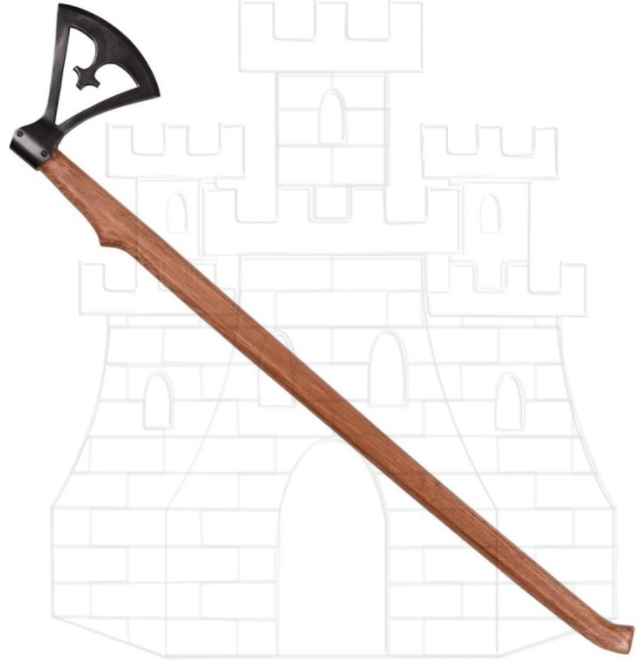
The axe influenced Viking combat tactics by offering them a versatile, light, and efficient weapon that allowed for quick and precise attacks capable of penetrating armor and breaking shields. Its design, like that of the bearded axe or the Danish axe, facilitated maneuvers in both hand-to-hand combat and long-range throwing, increasing the tactical adaptability of the warriors. Additionally, Vikings used special grip techniques to hook and control opponents, and the combination of the axe with other weapons enriched their formations and fighting styles. This versatility and effectiveness made the axe a symbol of power, agility, and skill on the battlefield, fundamental to Viking tactics, especially for berserkers who leveraged their brute strength.
What symbolism did the Viking axe hold in Norse culture?
The Viking axe symbolized strength, war, courage, and protection in Norse culture. Furthermore, it represented power in both a military and social sense, serving as an emblem of status for warriors and leaders when decorated. In Norse mythology, it was linked to deities like Thor and Freyr, symbolizing the ability to give and take life, thus reflecting the duality between destruction and protection.
What characteristics made the Danish axe so feared in combat?
The Danish axe was feared in combat due to its long handle (up to 1.5 meters) which provided great reach, and its wide and thin blade (approximately 30 cm) of hard iron, capable of inflicting devastating cuts. Its design allowed it to be wielded with both hands, combining power and mobility, making it especially lethal against lightly armored enemies and in close-quarters combat. Additionally, its lighter head compared to other battle axes facilitated fast and flexible attacks without losing offensive power. All of these factors made the Danish axe an imposing and effective weapon in battle.
The questions begin with the symbol ¿ and end with the question mark ?, and here these guidelines have been followed for each question.
| Type of Oil | Main Characteristics | Recommended Use |
|---|---|---|
| Mineral Oil | High penetration, does not degrade or attract dirt | Regular protection and maintenance |
| Camellia Oil | Natural, acid-free, non-volatile | Antioxidant protection, lubrication |
| Lithium Grease | Dense, durable, does not evaporate | Long-term storage, protection |
- Mineral Oil
-
- Characteristics: High penetration, does not degrade or attract dirt
- Recommended Use: Regular protection and maintenance
- Camellia Oil
-
- Characteristics: Natural, acid-free, non-volatile
- Recommended Use: Antioxidant protection, lubrication
- Lithium Grease
-
- Characteristics: Dense, durable, does not evaporate
- Recommended Use: Long-term storage, protection
VIEW FUNCTIONAL AXES | VIEW DECORATIVE AXES | VIEW MORE AXES FOR LARP | VIEW VIKING AXES

